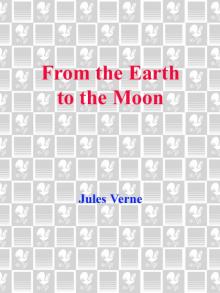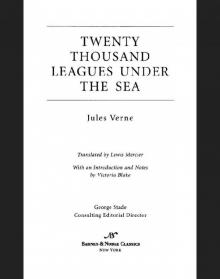- Home
- Jules Verne
From the Earth to the Moon Page 4
From the Earth to the Moon Read online
Page 4
* A mixture of rum, orange juice, sugar, cinnamon, and nutmeg. This yellowish liquid is drunk from mugs through glass straws.
** An appalling drink of the lower classes.
* A pocket weapon made of flexible whalebone and a metal ball.
CHAPTER 4
REPLY FROM THE CAMBRIDGE OBSERVATORY
MEANWHILE, AMID all the acclaim that was being given him, Barbicane was not wasting time. The first thing he did was to assemble his colleagues in the offices of the Gun Club. There, after discussing the matter, they agreed to consult some astronomers on the astronomical aspects of the project; then, when the reply had been received, they would consider the mechanical means, and nothing would be neglected in assuring the success of the great experiment.
A letter containing a number of precisely worded questions was sent to the observatory at Cambridge, Massachusetts. This city, where the first university in the United States was founded, is justly famous for its observatory. The staff attached to it is composed of scientists of the greatest merit; its powerful telescope is the one that enabled Bond to resolve the nebula of Andromeda, and Clarke to discover the satellite of Sirius. The Gun Club’s confidence in this renowned establishment was therefore fully justified.
Two days later, the impatiently awaited reply was delivered to Barbicane:
Cambridge, October 7
Mr. Impey Barbicane
President of the Gun Club
Baltimore, Maryland
Dear Mr. Barbicane,
On receipt of your letter of October 6, addressed to the Cambridge Observatory in the name of the Gun Club, our staff met immediately and drew up the following reply.
Your questions were these:
Is it possible to send a projectile to the moon?
What is the exact distance between the earth and the moon?
If a projectile is given sufficient initial velocity, how long will it be in flight, and when must it be launched in order for it to strike the moon at a given point?
At what precise time is the moon in the most favorable position for being reached by the projectile?
At what point in the sky must the cannon that will launch the projectile be aimed?
What will be the position of the moon when the projectile is launched?
Concerning the first question: Is it possible to send a projectile to the moon?
Yes, it is possible to do so, if the projectile is given an initial velocity of 36,000 feet per second. Calculation shows that this velocity is sufficient. As one moves away from the earth, the force of gravity diminishes in inverse ratio to the square of the distance; that is, for a distance three times as great, the force is nine times as small. Therefore, the weight of the projectile will decrease rapidly and will finally be reduced to zero when the gravitational pull of the moon balances that of the earth, which will occur when forty-seven fifty-seconds of the total distance has been covered. If it goes beyond that point, the projectile will be drawn to the moon by lunar gravity alone. The theoretical possibility of the feat is established beyond question; its actual accomplishment will depend solely on the power of the cannon employed.
Concerning the second question: What is the exact distance between the earth and the moon?
The moon does not describe a circle around the earth but an ellipse, one of whose foci is occupied by the earth. The moon is thus nearer to the earth at some times than at others, or, in astronomical terms, it is sometimes at its apogee and sometimes at its perigee. The difference between the two distances is not negligible. At its apogee the moon is 247,552 miles from the earth, and at its perigee it is 218,657 miles away, making a difference of 28,895 miles, or a ninth of the total distance. Calculations should therefore be based on the distance to the moon at its perigee.
Concerning the third question: If a projectile is given sufficient initial velocity, how long will it be in flight, and when must it be launched in order for it to strike the moon at a given point?
If the projectile kept its initial velocity of 36,000 feet per second, it would take only about nine hours to reach its destination; but its velocity will be constantly diminishing, and calculation shows that it will take 300,000 seconds, or eighty-three hours and twenty minutes, to reach the point where the earth’s gravity is balanced by the moon’s, and from this point it will fall to the moon in 50,000 seconds, or thirteen hours, fifty-three minutes, and twenty seconds. It should therefore be launched ninety-seven hours, thirteen minutes, and twenty seconds before the moon arrives at the point of aim.
Concerning the fourth question: At what precise time is the moon in the most favorable position for being reached by the projectile?
As has been said above, the projectile should be launched when the moon is at its perigee. Furthermore, it should be launched when the moon is at the zenith.* This will diminish the distance by the length of the earth’s radius, i.e., 3,919 miles, so that the actual distance to be covered will be 214,973 miles. But while the moon reaches its perigee each month, it is not always at the zenith when it does so. These two conditions coincide only at long intervals. The projectile should not be launched until they do. Fortunately this will be the case on December 4 of next year: at midnight the moon will be at its perigee, i.e., at its shortest distance from the earth, and at the same time it will reach the zenith.
Concerning the fifth question: At what point in the sky must the cannon that will launch the projectile be aimed?
From the foregoing it is clear that the cannon must be aimed at the zenith, so that the line of fire will be perpendicular to the plane of the horizon, and the projectile will escape from the earth’s gravity more rapidly. But in order for the moon to rise to the zenith of a given place the latitude of the place must be no greater than the moon’s declination; that is, the place must lie somewhere between the equator and the twenty-eighth parallel, either north or south.* At any other point, the line of fire would have to be oblique, and that would be detrimental to the success of the undertaking.
Concerning the sixth question: What will be the position of the moon when the projectile is launched?
When the projectile is launched, the moon, which advances thirteen degrees, ten minutes, and thirty-five seconds each day, will have to be four times that far from the zenith, or fifty-two degrees, forty-two minutes, and twenty seconds. This represents the distance it will cover during the flight of the projectile. But since the deviation imparted to the projectile by the rotation of the earth must also be taken into account, and since the projectile will not reach the moon until after it has deviated a distance equal to sixteen times the radius of the earth, which is equivalent to eleven degrees of the moon’s orbit, these eleven degrees must be added to the fifty-two degrees mentioned above. Thus when the projectile is launched, the moon will be at an angle of approximately sixty-four degrees from the vertical.
Such are the answers to the questions asked of the Cambridge Observatory by the members of the Gun Club.
To sum up:
The cannon must be located no more than twenty-eight degrees from the equator.
It must be aimed at the zenith.
The projectile must be given an initial velocity of 36,000 feet per second.
It must be launched on December 1 of next year, at thirteen minutes and twenty seconds before eleven o’clock at night.
It will strike the moon four days after its departure, on December 4 at exactly midnight, just as the moon reaches the zenith.
The members of the Gun Club must therefore begin work without delay and be ready to launch their projectile at the right time, for if they miss the date of December 4 they will not find the moon in the same conditions of perigee and zenith until eighteen years and eleven days later.
The staff of the Cambridge Observatory is entirely at your disposal for questions of theoretical astronomy, and joins its congratulations to those of all America.
Sincerely,
J. M. Belfast
Director
*
The zenith is the point in the sky directly above the observer.
* Only between the equator and the twenty-eighth parallel does the moon reach the zenith at its culmination. Beyond the twenty-eighth parallel, it approaches the zenith less and less as one moves toward the pole.
CHAPTER 5
THE ROMANCE OF THE MOON
AN OBSERVER endowed with infinitely penetrating vision, and placed at the unknown center around which the world gravitates, would have seen myriads of atoms filling space during the chaotic period of the universe. But gradually, as the centuries passed, a change took place; a law of attraction manifested itself and was obeyed by the atoms that had hitherto been wandering; they combined chemically, according to their affinities, grouped themselves into molecules and formed those nebulous masses which are strewn throughout the depths of space.
Each one of these masses soon acquired a movement of rotation around its central point. This center, composed of sparse molecules, began spinning and progressively condensing. In accordance with the immutable laws of mechanics, as its volume was diminished by condensation, its rotary motion was accelerated. From the continuation of these two effects there resulted a principal star, the center of the nebulous mass.
If he had watched attentively, the observer would then have seen other molecules in the mass behaving like the central star: condensing in a constantly accelerating rotary motion as it had done, and gravitating around it in the form of countless stars. A nebula had been formed. Astronomers now count nearly five thousand of them.
Among these five thousand nebulae there is one which men have named the Milky Way. It contains eighteen million stars, each one of which has become the center of a solar world.
If the observer had particularly examined one of the smallest* and brightest of those eighteen million stars, the one we proudly call the sun, all the phenomena to which the formation of the universe is due would have taken place before his eyes.
He would have seen the sun, still in a gaseous state and composed of loose molecules, turning on its axis to complete its work of concentration. This motion, faithful to the laws of mechanics, accelerated as the sun’s volume decreased, and finally the time came when centrifugal force prevailed over centripetal force, which tends to push molecules toward the center.
Then another phenomenon would have taken place before the observer’s eyes. Molecules located in the plane of the equator, escaping like a stone from a sling whose cord has just snapped, formed several concentric rings around the sun, like those of Saturn. These rings of cosmic matter rotated around the central mass, then began disintegrating and breaking up into secondary masses, i.e., into planets.
If the observer had watched these planets he would have seen them acting exactly like the sun and giving birth to one or more cosmic rings. This was the origin of those minor bodies known as satellites.
Thus, in going from the atom to the molecule, from the molecule to the nebulous mass, from the nebulous mass to the nebula, from the nebula to the principal star, from the principal star to the sun, from the sun to the planet, and from the planet to the satellite, we have the whole series of transformations undergone by heavenly bodies since the first days of the world.
The sun seems lost in the immensities of the stellar world, and yet current scientific theory tells us that it is part of the Milky Way. It is the center of a world, and, however small it may seem in the vast reaches of space, it is actually enormous, for its size is 1,400,000 times greater than that of the earth. Around it gravitate the eight planets that came from its entrails at the beginning of creation. In order of nearness to the sun, they are: Mercury, Venus, Earth, Mars, Jupiter, Saturn, Uranus, and Neptune. In addition, moving in regular orbits between Mars and Jupiter, there are smaller bodies which may be the debris of a larger body broken into thousands of pieces. The telescope has revealed ninety-seven of them so far.*
Some of these attendants of the sun, held in their elliptical orbits by the great law of gravitation, have their own satellites. Uranus and Saturn have eight each, Jupiter has four, Neptune may have three, the earth has one. The latter, one of the smallest in the solar system, is called the moon, and it was the objective that the bold American spirit had set out to conquer.
Because of its relative nearness and the rapidly changing spectacle of its various phases, the moon shared man’s attention with the sun from the very beginning. But the sun is tiring to the eyes, and the splendor of its light soon forces those who look at it to avert their gaze.
Pale Phoebe, however, is more humane; she graciously lets herself be seen in all her modest charm; she is unassuming and gentle to the eye, and yet she sometimes takes the liberty of eclipsing her brother, the radiant Apollo, without ever being eclipsed by him. Realizing the debt of gratitude they owed to this faithful friend of the earth, the Mohammedans established their month in accordance with her revolution.*
The ancient nations worshiped that chaste goddess. The Egyptians called her Isis, the Phoenicians Astarte; the Greeks worshiped her under the name of Phoebe, daughter of Leto and Zeus, and they explained her eclipses by her mysterious visits to the handsome Endymion. Mythology tells us that the Nemean lion roamed the moon before appearing on earth, and the poet Agesianax, quoted by Plutarch, celebrated in his verses the gentle eyes, charming nose, and gracious mouth formed by the bright parts of the adorable Selene.
Although the ancients had a good understanding of the character, temperament, and general moral qualities of the moon from a mythological point of view, even the most learned of them were extremely ignorant of its physical nature.
Some ancient astronomers, however, discovered certain things about the moon that have been confirmed by modern science. While the Arcadians claimed to have lived on the earth at a time when the moon did not yet exist, while Tatius regarded it as a fragment of the sun, while Aristotle’s disciple Clearchus held it to be a smooth mirror in which images of the ocean were reflected, and while others saw it only as a mass of vapor given off by the earth or a revolving globe that was half fire and half ice, a few learned men, by means of shrewd observations, lacking optical instruments, surmised most of the laws that govern it.
Thus Thales of Miletus, five hundred years before the birth of Christ, voiced the opinion that the moon was illuminated by the sun. Aristarchus of Samos gave the correct explanation of its phases. Cleomedes taught that it shone with reflected light. The Chaldean Berosus discovered that the duration of its rotation was equal to that of its revolution, and in this way he was able to explain the fact that it always presents the same side to the earth. Finally Hipparchus, nearly two centuries before Christ, recognized certain irregularities in its apparent motions.
These various observations were later confirmed, and were beneficial to later astronomers. Ptolemy in the second century, and the Arab Abul Wefa in the tenth, completed Hipparchus’ discoveries concerning the irregularities of the moon’s motion as it describes the undulating line of its orbit under the influence of the sun. Then Copernicus in the fifteenth century, and Tycho Brahe in the sixteenth, completely described the solar system and the part played by the moon in the assemblage of heavenly bodies.
At that time its motions were determined more or less accurately, but little was known of its physical constitution. Then Galileo explained the light phenomena that occurred at certain phases of the moon by the existence of mountains on its surface. He placed their average height at 27,000 feet.
Hevelius, a Danzig astronomer, later lowered the greatest heights to 15,600 feet, but his colleague Riccioli brought them up to 42,000.
At the end of the eighteenth century, Herschel, armed with a powerful telescope, drastically reduced the previous measurements. He gave 11,400 feet to the highest mountains and brought the average to only 2,400. But he, too, was mistaken. It took the observations of Schroeter, Louville, Halley, Nasmyth, Bianchini, Pastorf, Lohrmann, and Gruithuysen, and especially the patient studies of Beer and Moedeler, to settle the matter definitively.
Thanks to these scientists, the height of the mountains of the moon is now perfectly known. Beer and Moedeler measured 1,905 mountains, of which six are greater than 15,600 in height, and twenty-two are higher than 14,400 feet.* The tallest peak rises 22,806 feet above the surface of the moon.
At the same time, visual exploration of the moon was being completed. It was seen to be riddled with craters, and its essentially volcanic nature became increasingly apparent with each observation. From the absence of refraction in the light from planets occulted by it, the conclusion was drawn that it must have almost no atmosphere. This lack of atmosphere implied a lack of water. It was therefore obvious that, to live under such conditions, the lunar inhabitants must have a special constitution and be radically different from the inhabitants of the earth.
Finally, thanks to new methods, improved instruments constantly scanned the moon, leaving no part of its visible surface unexplored, even though its diameter is 2,150 miles, about a quarter of the earth’s, its area is one-thirteenth that of the earth, and its volume one-forty-ninth. None of these secrets could escape the eyes of the astronomers, and the skilled scientists carried their prodigious observations still further.
Thus they noticed that when the moon was full there were white lines across it, and black lines during its phases. They studied these lines with greater precision and succeeded in determining their nature. They were long, narrow furrows with parallel edges, usually ending in the vicinity of a crater, about fifty feet wide and anywhere from ten to a hundred miles long. The astronomers called them “grooves,” but giving them that name was all they could do. As for the question of whether or not these grooves were the dry beds of former streams, they could not answer it satisfactorily. The Americans hoped to be able to solve this geological puzzle some day. They also intended to reconnoiter that series of parallel ramparts discovered on the surface of the moon by Gruithuysen, a learned Munich professor, who regarded them as a system of fortifications erected by lunar engineers. These two obscure points, and no doubt many others, could not be definitely settled until there had been direct communication with the moon.

 Michael Strogoff; Or the Courier of the Czar: A Literary Classic
Michael Strogoff; Or the Courier of the Czar: A Literary Classic Voyage au centre de la terre. English
Voyage au centre de la terre. English Journey Through the Impossible
Journey Through the Impossible The Castaways of the Flag
The Castaways of the Flag L'île mystérieuse. English
L'île mystérieuse. English Maître du monde. English
Maître du monde. English Around the World in Eighty Days
Around the World in Eighty Days A Voyage in a Balloon
A Voyage in a Balloon From the Earth to the Moon, Direct in Ninety-Seven Hours and Twenty Minutes: and a Trip Round It
From the Earth to the Moon, Direct in Ninety-Seven Hours and Twenty Minutes: and a Trip Round It Paris in the Twentieth Century
Paris in the Twentieth Century City in the Sahara - Barsac Mission 02
City in the Sahara - Barsac Mission 02 The English at the North Pole
The English at the North Pole The Field of Ice
The Field of Ice From the Earth to the Moon
From the Earth to the Moon Un capitaine de quinze ans. English
Un capitaine de quinze ans. English The Mysterious Island
The Mysterious Island Les indes-noirs. English
Les indes-noirs. English Robur-le-conquerant. English
Robur-le-conquerant. English Propeller Island
Propeller Island Around the World in Eighty Days. Junior Deluxe Edition
Around the World in Eighty Days. Junior Deluxe Edition Les forceurs de blocus. English
Les forceurs de blocus. English In the Year 2889
In the Year 2889 Journey to the Centre of the Earth
Journey to the Centre of the Earth Twenty Thousand Leagues Under the Sea
Twenty Thousand Leagues Under the Sea From the Earth to the Moon; and, Round the Moon
From the Earth to the Moon; and, Round the Moon Vingt mille lieues sous les mers. English
Vingt mille lieues sous les mers. English Cinq semaines en ballon. English
Cinq semaines en ballon. English Twenty Thousand Leagues under the Seas
Twenty Thousand Leagues under the Seas Face au drapeau. English
Face au drapeau. English Michael Strogoff; Or, The Courier of the Czar
Michael Strogoff; Or, The Courier of the Czar Un billet de loterie. English
Un billet de loterie. English The Secret of the Island
The Secret of the Island Off on a Comet! a Journey through Planetary Space
Off on a Comet! a Journey through Planetary Space Into the Niger Bend: Barsac Mission, Part 1
Into the Niger Bend: Barsac Mission, Part 1 All Around the Moon
All Around the Moon A Journey to the Center of the Earth - Jules Verne: Annotated
A Journey to the Center of the Earth - Jules Verne: Annotated 20000 Lieues sous les mers Part 2
20000 Lieues sous les mers Part 2 Robur-le-Conquerant
Robur-le-Conquerant Les Index Noires
Les Index Noires Michael Strogoff; or the Courier of the Czar
Michael Strogoff; or the Courier of the Czar 20000 Lieues sous les mers Part 1
20000 Lieues sous les mers Part 1 Twenty Thousand Leagues Under the Sea (Barnes & Noble Classics Series)
Twenty Thousand Leagues Under the Sea (Barnes & Noble Classics Series) Five Weeks In A Balloon
Five Weeks In A Balloon Journey to the Center of the Earth
Journey to the Center of the Earth 20,000 Leagues Under the Sea
20,000 Leagues Under the Sea Journey to the Center of the Earth (Barnes & Noble Classics Series)
Journey to the Center of the Earth (Barnes & Noble Classics Series) Adrift in the Pacific-Two Years Holiday
Adrift in the Pacific-Two Years Holiday The Collected Works of Jules Verne: 36 Novels and Short Stories (Unexpurgated Edition) (Halcyon Classics)
The Collected Works of Jules Verne: 36 Novels and Short Stories (Unexpurgated Edition) (Halcyon Classics) The Survivors of the Chancellor
The Survivors of the Chancellor Their Island Home
Their Island Home Le Chateau des Carpathes
Le Chateau des Carpathes Les Cinq Cents Millions de la Begum
Les Cinq Cents Millions de la Begum The Floating Island
The Floating Island Cinq Semaines En Ballon
Cinq Semaines En Ballon Autour de la Lune
Autour de la Lune